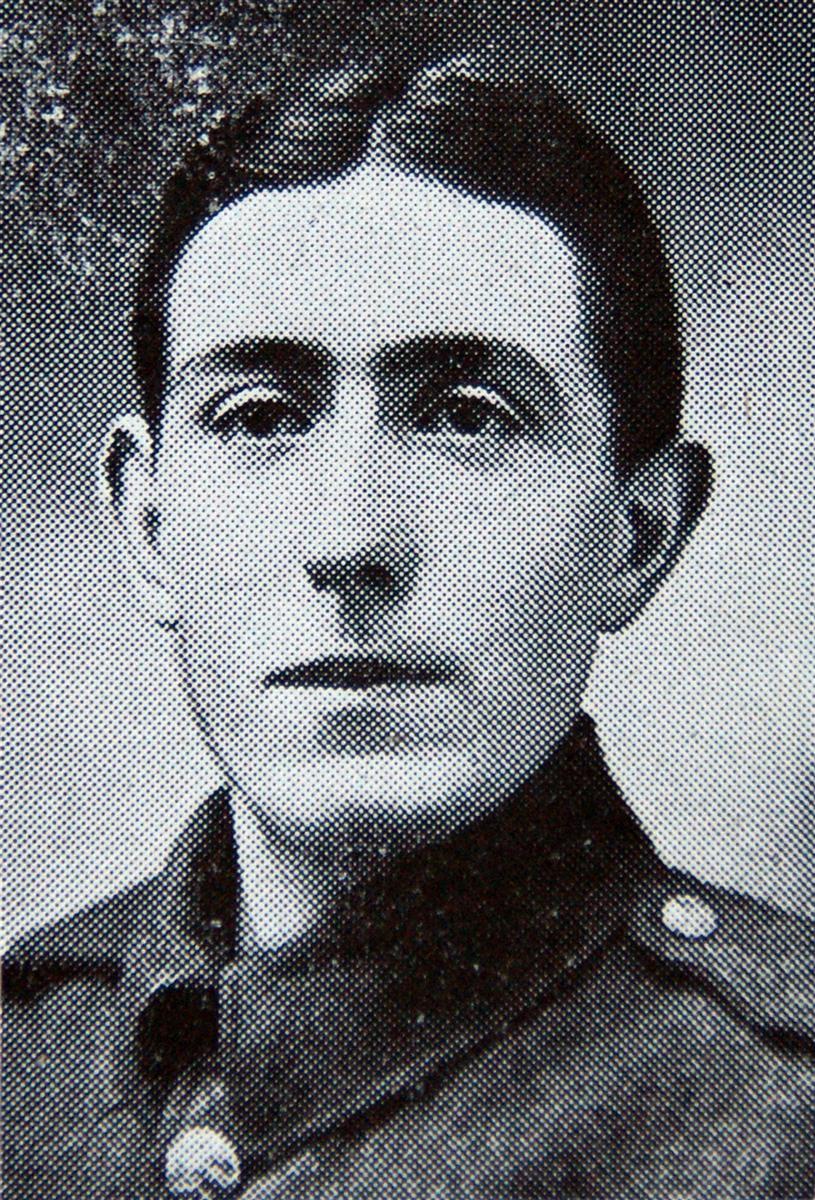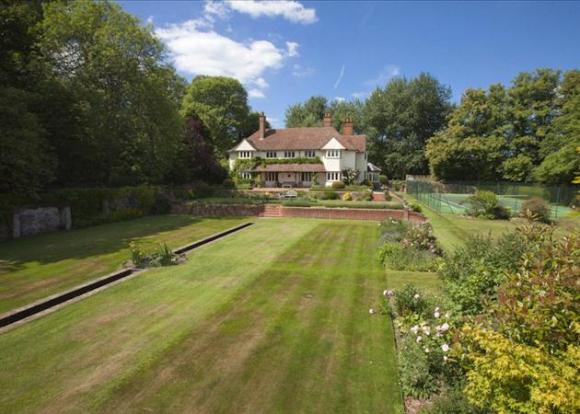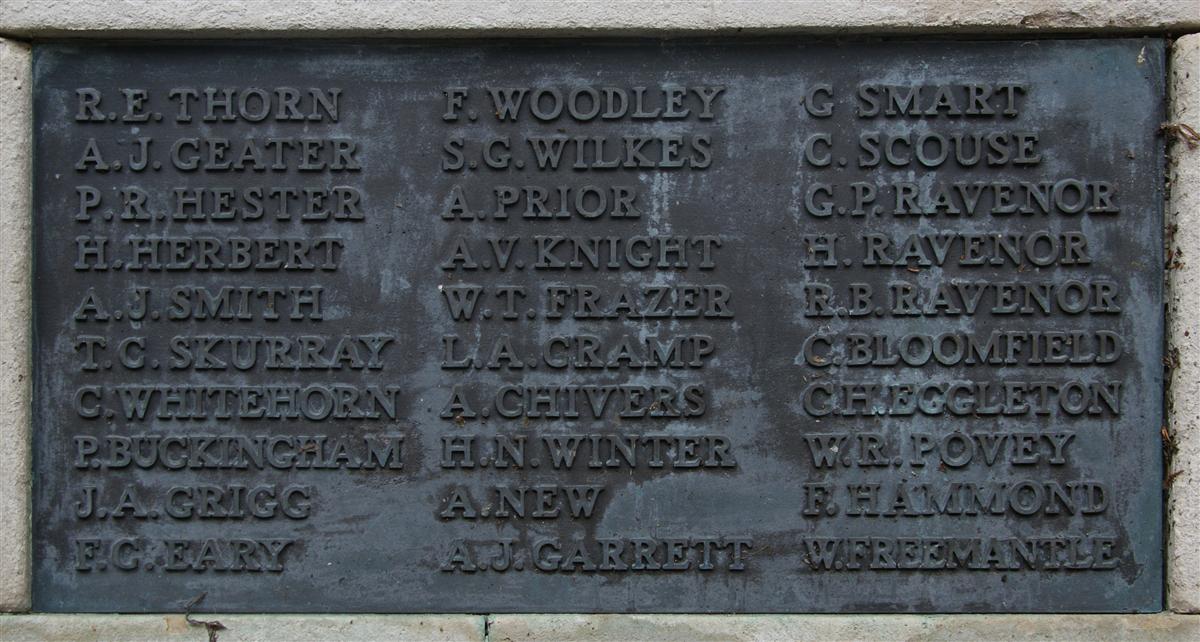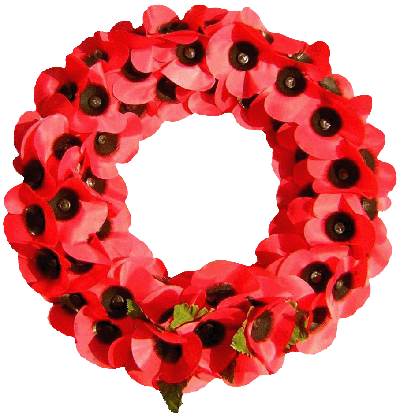Clement Irvine Bloomfield
There is some doubt about the identification of Clement Irvine Bloomfield as the C Bloomfield on Newbury War Memorial. It is thought that he is also the Charles Bloomfield, Royal Berkshire Regiment recorded on the lost memorial at Speenhamland School and the C W Bloomfield on the Shaw cum Donnington memorial. However, there are alternative explanations:
Charles William Stanley Bloomfield, 2nd/4th Battalion, Royal Berkshire Regiment

Charles Bloomfield. |
Charles William Stanley Bloomfield from Greenham who, according to the Active Service Roll maintained by the Newbury Weekly News, served in the ‘4th Royal Berks’, could perhaps have attended Speenhamland School, however, he survived the war serving on beyond the end of the war earning a clasp to his General Service Medal to commemorate his service on the North West Frontier in 1919.
Charles's photograph appears in Berkshire at War, a pictorial publication from the Reading Standard, that gives his address as 8 Junction Terrace, Greenham, Newbury. A report of his loss was also printed in the local paper:
Newbury Weekly News, 2 May 1918 – Missing
BLOOMFIELD – Any news of Pte C Bloomfield, sniper in the 2/4th Berks Regiment, eldest son of Mr and Mrs Bloomfield, of 8, Junction Terrace, Greenham, who is reported to be missing, will be thankfully received by his parents.
This was from the time of the German Spring Offensive – when missing was somewhat less likely to mean dead – as the British lines were rolled back towards Amiens a great many prisoners were taken - including Charles. However, ‘missing’ had become almost synonymous with ‘dead’ – if Charles was out of contact with Newbury friends and family could he have been assumed to be dead?
The Shaw memorial was dedicated in December 1918; it is possible that no news had been heard of Charles by then and that he was assumed to be dead. However, there is no known link to Shaw.
Charles Bloomfield, Royal Berkshire Regiment (Speenhamland School)
The Speenhamland School memorial was not dedicated until 1920; even if he went to the school, surely Charles' survivial would have been known of by then?
No other Charles Bloomfield appears in census returns for the area in 1901 or 1911 so it is surmised that Clement spent the later year or two of his education at Speenhamland (he was over 10 before the family moved to the area), perhaps he was known as ‘Charlie’? There remains the possibility of a Charles Bloomfield coming to light; until that time Clement’s story shall be told in explanation of the sacrifice of little ’Charles Bloomfield’.
C W Bloomfield (Shaw cum Donnington Memorial)
In reality C W Bloomfield was probably Clement’s brother Clarence William, who served with the ASC and survived the war. By the time the village war memorial was erected the Bloomfields had left the area, so it is, perhaps, understandable that the initials were confused. Local records of service did not exist, the most readily available source of information was the local paper, the Newbury Weekly News. Up until March 1916 this paper regularly printed lists, which they called the ‘Active Service Roll’ of men who were serving, village by village. In March 1916 the entry for Shaw cum Donnington included Driver C W Bloomfield, ASC – but no C I Bloomfield. It seems likely that, knowing that one of the Bloomfield boys died they referred to this list and added Clarence’s initials rather than Clement’s.
C Bloomfield (Newbury War Memorial)
At first glance it appears that Clement Bloomfield is as likely an explanation for the name on the memorial as the elusive ‘Charles’ from Speenhamland School. However, it is apparent that the committee that gathered the names for the town memorial in 1922 did so in part by harvesting the names from the various memorials in churches and other sites around town. As the Speenhamland School tablet was erected in 1920 it is very likely that this was the source of ‘C Bloomfield’.
However, Clement was a Newbury resident for a number of years and his parents were resident in the town at the time of his death in 1916 – so his story deserves to be told:
Private 4920 Clement Irvine Bloomfield, 1st/4th Battalion, Royal Berkshire Regiment
Clement was born in 1894 in Kensington, the second son of William Bloomfield and his wife Eliza Ellen née Jefferies. William and Eliza married on 3 October 1889 and their first child, Eva was born the following year. Three more children followed, Clarence William (born 1893), Clement and Robert Firth (1901). William was a coachman and, sometime after Robert’s birth the family followed his work from London to Donnington, where he was employed as coachman to Frederick Saunders at Donnington Hurst.

Donnington Hurst - plenty of garden to keep William occupied. |
Clement went the Speenhamland School (St Mary’s Place was in Speenhamland), perhaps under the soubriquet of Charles or Charlie, thus earning a place on the memorial placed in the school in 1920?
After school Clement began work as a garden boy, probably at Donnington Hurst. This may well have been no more than a starter job, he may well have moved on to alternative employment before war broke out and his generation became embroiled in the nightmare of trench warfare. He enlisted in the Royal Berkshire Regiment (3rd/4th Battalion) on Whit-Tuesday 1915 and began his training at a camp in the grounds of Aldermaston Court.
He served in the 1st/4th (Territorial) Battalion of the Royal Berkshire Regiment. By March 1916 this battalion had been at the Front for almost a year, but Clement joined the 1st/4th in France in March 1916 almost certainly in one of the three drafts of men (totalling over 200) that joined the battalion that month.
This was shortly before the build up to the most famous offensive of the war, the Battle of the Somme. With sixty thousand casualties on the first day of the battle and many more in the 147 days that followed it was a battle that virtually every town and village had cause to remember. The 1st/4th Battalion was moved to the Somme area in early June in preparation for their involvement.
The Royal Berkshire Regiment was in action on the first day, when their 2nd Battalion went over the top on day one, 1 July 1916 – contributing 437 casualties to the 60,000+ total. The 5th Battalion followed on 3 July also suffering terrible losses. The 1st/4th Battalion were in the reserve trenches on 3 July, expecting to go into action but the attack they were due to take part in was cancelled; they had to wait until 23 July for their turn.
Their battalion war diary entry for that day tells little of their experience:
War Diary of 1/4th Royal Berks – 23 July 1916
France, La Boiselle: Our attack began at 4.0 A.M – see report. Their shell fire was incessant from dawn till dark. The captured trenches, our Right and all communication trenches being continually under fire. At 6.20 pm we received orders that the 5th WARWICKS would take over our front and this relief was completed by 3.0 am on the 24th. The Battalion did well in the attack and later when holding the captured trenches. Reinforcement of 46 joined the Battalion. Weather:- a fine day. Remarks Casualties – 2/Lts Clayton and Wakefield killed, 23 killed, 103 wounded, including shell shock 16.
The ‘report’ mentioned in the diary entry is a long account of the day from build up to aftermath. The description of the action is as follows:
About 3.0 a.m. orders were received from the Brigade to place one Company under command of the OXFORDS if required. About 3.55 a.m., from reports received from the OXFORDS, the position seemed to be serious in front, and Captain ALDWORTH, with both Companies [B & C], at once moved off to support them. The advance was carried out in perfect order, the lines moving as if on parade, in spite of the Machine Gun fire and barrage of shells put across by the enemy; the behaviour of all ranks could not have been braver or better. The position about 4.0 a.m. was critical, and I cannot speak too highly of the quickness with which Captain ALDWORTH realised how matters stood, or his able handling of the supports. In my opinion he contributed very materially to the success of the operations [Capt Attride received a Military Cross for his actions that day]. The objective as reached and the captured trenches consolidated. Messages were sent back for Bombs etc and Captain ATTRIDE at once organised carrying parties from D Company for the supply of bombs, tools, etc.; these were taken across the open, each party moving quite steadily, though it was broad daylight and the fire from Machine Guns and Artillery was heavy. A platoon of D Company was also sent up to assist Lieutenant DOWN, who was in command of the Right bombing party.All the arrangements made by Captain ATTRIDE worked most smoothly.
All day the captured trenches were held by us and the OXFORDS and from mid-day to dusk they were subjected to a very fierce bombardment, chiefly from 15c shells, and there were many casualties, but the line was held with the same steadiness as had been shown in the advance. All the trenches held by A Company were subjected to a similar bombardment.
In total the battalion suffered 242 casualties in the period 22-25 July, of which only 11 are recorded as ‘missing’. It was on the 23 July that Clement was reported as killed in action. As his body was never recovered it is most likely that he was a victim of the shelling at some time during the day. He is remembered on the magnificent Thiepval memorial to the missing of the Somme (Pier 11, Face D).
The news reached Newbury a month later:
Newbury Weekly News, 31 August 1916 p8 – Local War Notes
The death was announced last week of Pte Clement Irvine Bloomfield, son of Mr and Mrs W Bloomfield, late of the lodge, Donnington Hurst. He enlisted in the Royal Berks on Whit-Tuesday, 1915, and was trained at Aldermaston, Reading and Weston-super-Mare. He went abroad in March of this year and his last field-card was dated July 14th. His mother received the sad news that he was killed instantaneously on July 24th, and a letter from his captain stating that he had done his duty splendidly, be always a willing soldier. Another son is serving in the ASC MT.
While it is possible that his Captain’s account that he was killed on 24 July is possible, the official date as recorded by the Commonwealth War Graves Commission was 23 July, and it was on that date that the battalion suffered its heaviest casualties.

Clement's name on Newbury War Memorial (middle right) |
Locally Clement is believed to be the man remembered on Tablet 12 of the Newbury Town War Memorial (as C Bloomfield), on the Shaw cum Donnington parish memorial (as C W Bloomfield) and on the lost memorial in Speenhamland School (as Charles Bloomfield).
The brother mentioned in the newspaper account of Clement’s death is his elder brother, Clarence William Bloomfield. Before the war Clarence worked as a motor car driver (following his father’s footsteps in an up-to-date fashion). His ability to drive was key to his being allocated to the Army Service Corps as soon as be turned up at the recruiting office – they were desperate for drivers to help in the immense logisitics operation required to supply the fighting men with everything they needed from arms and ammunition to the basics of living as wells as the construction materials and tools needed to build defences, shore up trenches, lay roads, etc, etc. As an experienced driver he was given only basic military training and was in France within six months of attesting on 1 February 1915. He spent almost four years in France and Flanders but survived to be discharged to the Reserve in July 1919. He did get at least one home leave, which enabled him to marry his sweetheart, Violet Wooller, in her home village, Willingdon, Sussex on 22 July 1917. Violet then lived with Clarence’s parents who had by this time moved from the Newbury area to Windsor.
Thanks to Karen Newbury for her help researching this soldier and to John Chapman for his excellent account of the activities of the Royal Berkshire Regiment.

